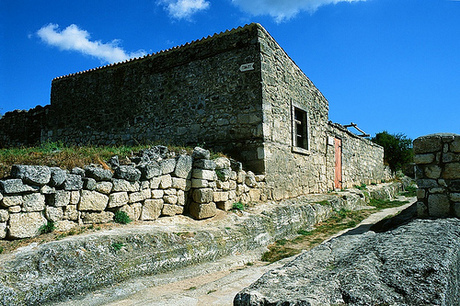Chufut-Kale
The limestone escarpments around Bakhchisarai are riddled with caves, which served as home to neolithic inhabitants long before the first recorded settlements. The remains of Chufut-Kale (`Jewish fortress') lie at the head of a steep-sided valley on the outskirts of Bakhchisarai, about a mile's walk from the Khan's Palace.
It's a combination of caves and the ruins of buildings which were built around and above them. The views from the top are stunning and well worth the climb.
The mouths of caves gape everywhere in cliffs sculpted by centuries of wind and rain. The earliest references to the town are as a Byzantine outpost. In 1299 it was besieged and captured by the Tatars, who lived there until the 16th century, when they moved down the valley to Bakhchisarai. Over the centuries of Tatar rule Karaite artisans and merchants moved into the town, and remained there after the Tatars left - hence the town's name.
When you're nearly at the plateau at the head of the valley, you'll pass two Knessa buildings (Karaim temples), partially restored, dating from the 14th and 18th centuries respectively.
You can tell why successive groups of inhabitants recognised the advantages of living here. The caves could be used for storage in peacetime and defense when under attack. But the strategic advantage of being able to see for miles in all directions from the top can't be overestimated.
Chufut-Kale (Tatar for "Jew's fortress") is located not far from Bakhchisaray, on the plateau that towers 200 m above neighboring valleys and is limited with precipices up to 50 m high from three sides. This fortress was established in the late 6th or 7th century as a Byzantine stronghold and populated with local tribes of the Alans, who were the allies of the Empire.
This town territory is traditionally divided into three well-visible parts: Burunchak, that is western section of the plateau where was no buildings, covering the area about 36 hectares; the Old town, covering the area of about 7 hectares, which was separated from the wasteland by a low wall; and the New town, covering more than 3 hectares and located between the Middle and the Eastern defensive walls.
The name of Kyrk-Or, or "forty forts" in Turkish, appeared in the 13th century. In 1340s, under Djanibek khan, the fortress fell into the hands of the Tartars. In the 15th century, Chufut-Kale became the first capital of the Crimean Khanate and the residence of the first Crimean khans Haji-Girey and Mengli-Girey. In the 16th century, the capital was moved to Bakhchesaray, and the population of Kyrk-Or restricted to a small Armenian community and, mainly, the Karaites, who adhered to a non-Talmud Judaism. From the 17th century onwards, the town was known as Chufut-Kale or "Jewish fortress."
The 17th century Ottoman traveler Evliya Celebi informed of another, little known name of this city: Gevherkermen, literally "Fortress of Treasures". In 1778, the Russian government organized the emigration of the Christians from the Crimea, after which only the Karaites continued to live in Chufut-Kale. The last inhabitant, the Karaite scholar and well-known collector of ancient manuscripts Avraam Firkovich, left Chufut-Kale in the late 19th century.
Today, the site of Chufut-Kale presents the fortification system with defensive walls, southern and eastern gates, and towers; streets with narrow sidewalks, dwelling houses, praying houses of the Karaites, or "kenassas"; the mausoleum of Djanike-Khanym who were the daughter of the khan Tokhtamysh; and cave constructions, which were carved for various purposes. You can get there by direct flight to Simferopol or through Kiev or Odessa.




